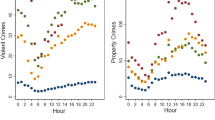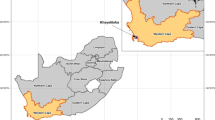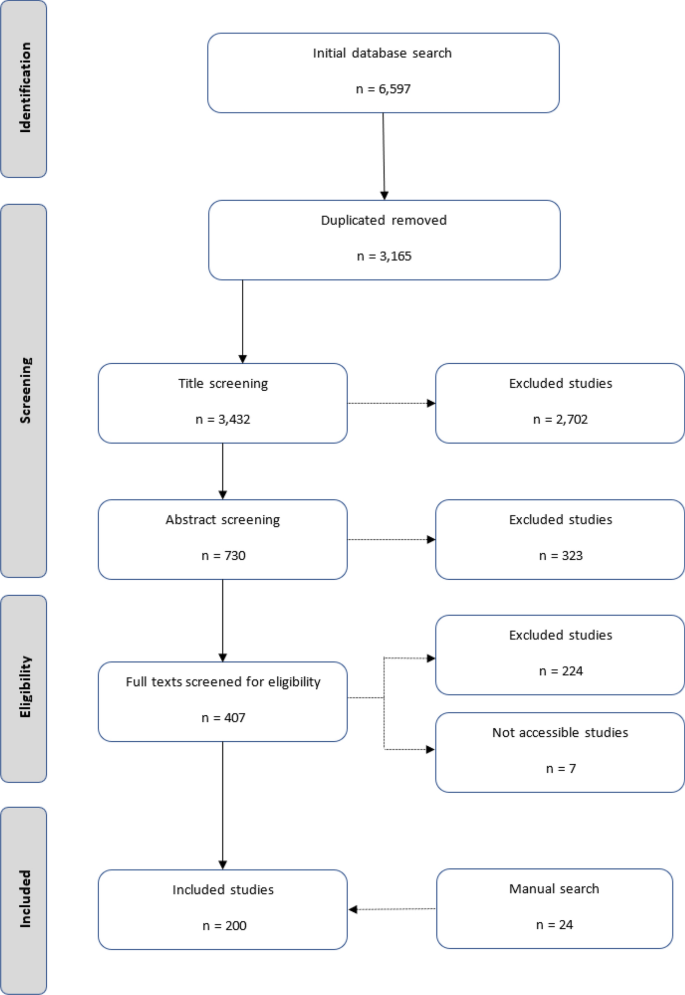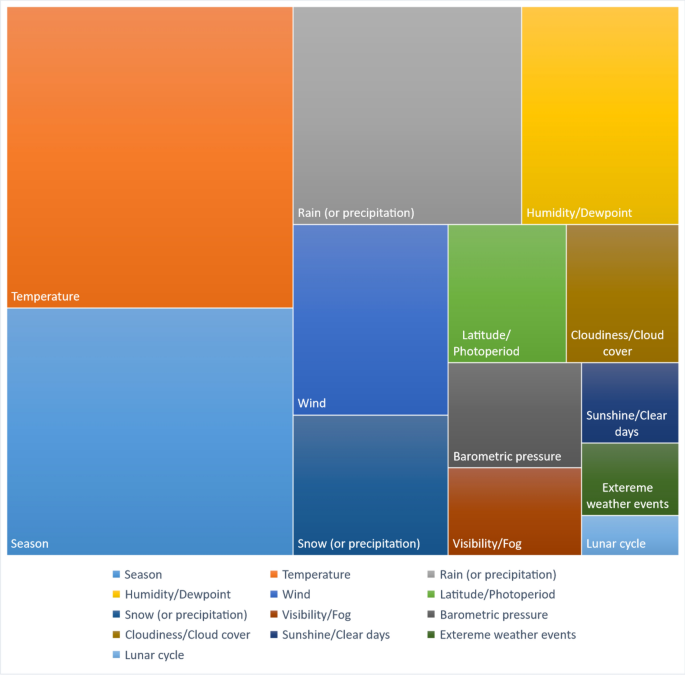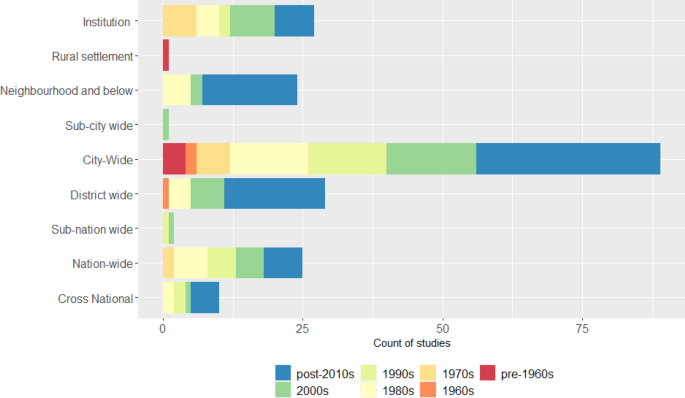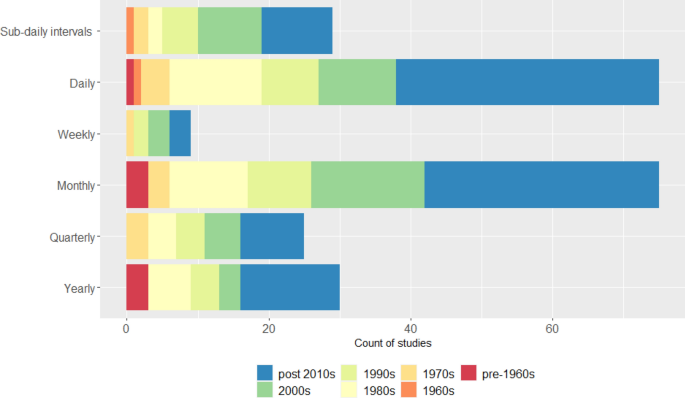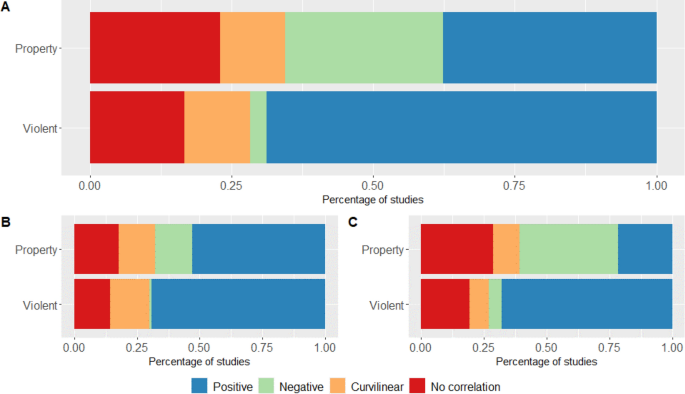Abstract
The weather-crime association has intrigued scholars for more than 150 years. While there is a long-standing history of scholarly interest in the weather-crime association, the last decade has evidenced a marked increase in the volume and diversity of empirical studies concerned with weather and its social implications including crime. In this paper we conduct a review of the empirical literature on weather and crime. This is the first review on the topic for more than 30 years. We highlight the theoretic and empirical challenges that persist and act to impede our understanding and chart four interrelated thematic areas that require concerted attention. These are to: (1) strengthen and integrate theoretical explanations of the weather-crime association; (2) model multi-dimensional processes of the weather-crime association; (3) broaden the situational, climatic, and cultural contexts of study; and (4) to translate research into policy and practice. We conclude by advocating for scholarship to advance the four thematic areas such that we progress towards a more complete and robust understanding of the weather-crime association.
Similar content being viewed by others
Background
Weather plays an intrinsic and ever-present role in our everyday lives. From the daily commute to our recreational pursuits, the weather shapes and structures activities and behavioural choices that we make (Cohn & Rotton, 2000; De Freitas, 1990). Through its capacity to influence where, when, and how daily activities take place, weather also has implications for crime (Cohn, 1993; Cohn & Rotton, 2000; LeBeau & Corcoran, 1990). Empirical research demonstrates a consistent link between higher temperatures and increased rates of violent crime (Anderson & Anderson, 1996; Butke & Sheridan, 2010; Cohn, 1993; Cook et al., 2012; Field, 1992; Hipp et al., 2004; LeBeau & Corcoran, 1990; Mapou et al., 2017; Michael & Zumpe, 1983; Michel et al., 2016; Ranson, 2014; Rotton & Cohn, 2003; Schinasi & Hamra, 2017). Yet, some discrepancies emerge between studies regarding operational definitions of weather phenomena; crime type; temporality and spatial unit of analysis. Inconsistencies also emerge between studies regarding the proposed pathway through which the weather-crime association operates.
Several theoretical perspectives have been applied, across disciplines, to explain the link between weather and crime. Most predominantly, recent scholarship adopts a framework based on routine activity theory or the generalised temperature aggression hypothesis. In the context of the weather-crime association, routine activity theory, posits that weather shapes individuals’ behavioural decisions and mobility over various granularities of time and in doing so conditions the location and timing of crime opportunities (Cohen & Felson, 1979; Cohn & Rotton, 2000; LeBeau & Coulson, 1996). The generalised temperature-aggression hypothesis, is grounded in human physiology and social psychology (Anderson, 1989) and suggests that high levels of heat and humidity induce physiological discomfort and psychological intolerance which exacerbate aggressive tendencies leading to impulsive offending (Anderson, 1989, Anderson & Anderson, 1996; Baron & Lawton, 1972). Contemporary weather-crime studies suggest these two pathways may be complementary and can be applied in conjunction with one another to explain the way in which weather conditions can (a) shape opportunities for physical encounters and social interactions between potential victims or targets and offenders; and (b) effect emotional responses and behavioural decisions during physical encounters and social interactions (Afon & Badiora, 2018; Hu et al., 2017; Schinasi & Hamra, 2017).
The weather-crime connection was first noted in the 1800s when Belgian astronomer Adophe Quetelet identified seasonal trends and summer peaks in violent crime in France (Quetelet, 1842, see also Dexter, 1899; Hill, 1884). Scholarly development on the association between weather and crime has continued over the ensuing decades with a notable peak in psychological and criminological studies in the 1990s. Since 2008, research interest in the weather-crime nexus has again increased with studies emerging from a range of disciplinary perspectives. Driven by data availability, ease of access to requisite weather and crime data and most importantly increasing concern over extreme weather events and the effects of climate change, there is currently a renewed focus on understanding the social consequences of weather to inform preparedness strategies.
In a systematic review of weather-crime research conducted in 1990s, Cohn (1990) noted most studies found evidence to support a positive, linear association between temperature and rates of violent crime. However, research on property and non-aggressive crimes was limited and there was no evidence of an association between heat and higher rates of these crime types. In concluding the review, Cohn (1990) highlighted four important considerations for future research on the relationship between weather and crime: (1) theoretical grounding; (2) operational measures of crime and weather (3) temporal granularity, and; (4) statistical techniques. Thirty years on from this study, and in the context of a renewed focus on weather and its social consequences in this paper we provide a systematic review of the weather-crime literature focusing on the four themes presented in Cohn’s 1990s review. Through concentrating on these themes, we provide insight into the primary developments in the field over the last three decades, explore the extent to which research has addressed these considerations and identify the gaps in current knowledge.
As humanity begins to realise the immediacy of climate change consequences to include the increased frequency and severity of prevailing weather conditions, a comprehensive understanding of the weather-crime association is required to inform practical policing, planning and place management policies. Fortunately, data availability and access to weather and crime data at fine temporal and spatial granularities has never been greater, alongside consideration of some of the theoretical weather-crime pathways that climate change might activate (Miles-Novelo & Anderson, 2019, 2022). Here we synthesise the current state of the weather-crime literature and explore the extent to which research has addressed needs first identified by Cohn (1990), to inform an agenda for future weather-crime research.
Methods: protocol and capture
Our review follows the principles laid out in the PRISMA Statement for Reporting Systematic Reviews (Moher et al., 2009). See Additional file 1: Table S1. We draw on this “mixed-method review” methodology (Gough, 2015) to build an understanding of both empirical results and theoretical developments in the field. Adopting this approach permits us to integrate the standard methods of a systematic review (e.g., selection of keywords and sources and eligibility criteria) alongside the openness and flexibility of traditional literature reviews. No review protocol was used in this study.
The articles that constituted the review were captured via a search of three databases; (1) Google Scholar; (2) Web of Science; and (3) Scopus. A complementary suite of keywords that together incorporate the range of terms associated with weather-crime studies were employed. Search terms were derived from a combination of the authors’ knowledge of the research space alongside terms that arose through the course of the systematic review process. The primary search term was “weather AND crime” alongside substituting ‘crime’ with specific crime types that included: ‘assault’; ‘homicide’; ‘murder’; ‘rape’; ‘robbery’; and ‘domestic violence’. In addition, the term ‘weather’ was also substituted with the following terms: ‘temperature’; ‘heat’; ‘photoperiod’; ‘season’ and ‘precipitation’. Furthermore, the reference lists of included studies were closely inspected such that we ensured a full coverage of all published articles in the weather-crime space. Searches were initially undertaken on 28th June 2021. The final intake of studies into the review was completed on 24th January 2022. To enhance the currency and coverage of the articles captured principles of the living systematic review methodology were adopted (Elliott et al., 2014).
In addition to our search terms (noted above) a set of inclusion and exclusion criteria were used. These criteria were:
-
Studies were included if they adopted an empirical approach to examine the weather-crime association.
-
Book reviews and magazines were excluded.
-
Only studies published in English were included.
The three criteria above were used to ensure we captured studies that offered a detailed empirical analysis of weather-crime associations. Further to these criteria we imposed no restrictions on when the study was published or the outlet in which the piece was published.
There are two limitations of the current review that require noting. First relates to the fragmentary nature of the weather-crime scholarship; that is to say that weather-crime scholarship is published across a suite of academic domains. This is highlighted by the fact that 11% (41 studies) of the included studies were identified from reference lists of studies captured in the systematic literature search. The range of keywords that were employed to locate the weather-crime literature generated a large volume of false-positive results. Second, there were a total of 7 studies that were not able to be progressed to a full screening as access to the full text was not possible. Each of these studies are listed in Additional file 1: Table S3.
Results and discussion: weather-crime scholarship
Publication timelines, weather parameters and crime types
Collectively, our search strategy initially returned approximately 6600 candidate documents (Fig. 1). After removing duplicates, titles and abstracts were screened for eligibility resulting in a reduction to 407 articles. The final stage involved a screening of full texts resulting in the removal of a further 224 articles and a total of 7 articles that were not able to be accessed. An additional 24 articles were manuallyFootnote 1 identified from other sources, resulting in a total of 200 studies being selected for analysis.
A total of 200 studies were published between 1842 and 2021(Table 1). Fifty percent of the included studies were published between 2004 and 2021, reflecting sustained interest in weather and its social consequences since the rise of the climate change agenda (see Additional file 1: Table S2). A total of 94.0% were published as journal articles, followed by 2.5% as books/book chapters and the remaining 3.5%, as conference papers, reports or theses.
Most frequently, studies (23.4%) examined the role of temperature followed by 19.2% that investigated the way in which season impacts crime. Figure 2 reports the total of thirteen weather parameters that have been investigated across all 200 studies. Over time, there has been a general increase in the variety of weather parameters explored.
The overwhelming majority of studies (72.9%) examined the effect of weather on violent crime (a category that includes rape and sexual assault, robbery, assault, crimes against the person and murder), with 27.1% investigating non-violent crime types (includes, auto theft, burglary, and other property crimes). Studies examining weather and violent crime were predominantly focused on: homicide (25%), assault (24%) and crimes against the person (15%). Studies examining weather and non-violent crimes most frequently focused on: property crimesFootnote 2 (43%); burglary (34%) and auto theft (23%).
Geographic and climatic contexts
Most frequently, studies (56.9%) examined the weather-crime association in a North American context that broadly represents the temperate bio-climatic zone. The next largest group of studies were focussed on Europe (17.2%), again largely representing study contexts situated in temperate climatic zones. Other climatic zones (including tropical, sub-tropical and cold climates) were underrepresented in the sampled weather-crime studies as were countries with economies other than ‘high income’ (For more details see Additional file 1: Table S3). Less studied parts of the world include Africa (n = 9) and South America (n = 5). In the case of both settings, all research dated post-2000 except for a single study in Johannesburg, South Africa conducted in 1980.
A small number of studies (n = 5) adopted a cross-national comparative frame of analysis. The first such study was conducted in 1986, the remaining four since 1999.
Geographical and temporal units of analysis
The most frequently adopted spatial unit is citywide accounting for 42.8% of all included studies (Fig. 3).Footnote 3 Studies focussed on a district scale account for the second most popular scale of analysis (13.9%) closely followed by those at an institutional scale (13.0%) examining the weather-crime relationship within health-related, educational, and correctional institutions. Notable is the emergence and growth of studies focussed on finer geographical units to include neighbourhoods and below. Rural settlements are the focus on only 1 study and have remained an under investigated spatial unit in weather-crime scholarship. (For more details see Additional file 1: Table S3).
The two temporal unit most employed is daily and monthly. Studies conducted using weather and crime data at the daily unit account for 30.9%, that is the same proportion of studies using a monthly unit of analysis (30.9%) (Fig. 4).Footnote 4 Fewer studies employed yearly (12.3%), quarterly (10.3%), weekly (3.7%) and sub daily (11.9%) temporal units. A notable number of studies (n = 47, 23.5%) examine the weather-crime association using multiple temporal units, the most typical combination of units being year and month (n = 8), followed by studies using three temporal units, specifically month, day, and sub-daily intervals (n = 7). There is evidence of a shift towards greater use of finer temporal units over the last two decades with daily and below daily units of analysis emerging as most common by 2010 and representing 44.3% of included studies in the years since 2010. (See Additional file 1: Table S3 for more details).
Empirical methods
Typically, studies on weather and crime use descriptive analysis. This strategy is employed by 41.7% of studies. Other approaches include analytic modellingFootnote 5 (34.8%), correlation (21.7%), and experimental methods (laboratory-based) (1.9%). Many of the included studies (n = 152 or 77.6%) contained multiple empirical elements the most typical combination being a descriptive analysis followed by a modelling component (n = 62). (See Additional file 1: Table S3 for more details).
Theoretical frameworks
One quarter of studies do not explicitly employ theoretic framing (25.0%) to explain study findings. Situational theories of crime appear most frequently as the primary theoretic framework (37.5%) followed by psychological (27.0%), physiological (5.0%), biological (3.0%), economic (1.5%) and finally social theories (1.0%).Footnote 6 A total of 28.4% of studies employ two and 3.4% use three theoretic frameworks to explain their findings, with the most used combination being Psychological and Physiological (accounting for 45.8% of the studies using two theoretic frameworks). In sum, situational studies predominantly cite Routine Activity Theory while psychological studies most commonly refer to the generalised temperature-aggression hypothesis. (For more details see Additional file 1: Table S3).
Findings
Exploring the findings for the most examined relationship in the weather-crime scholarship, namely temperature and season on property crime and violent crime reveals a varied picture. Of the 200 studies, 52.5% examined temperature and violent crimes, 39.5% season and violent crime, 29.5% temperature and property crime, and 26.5% season and property crime. By classifying the empirical relationship reported in each study into positive; negative; curvilinear or no correlation Fig. 5A reveals the relationships between season, temperature, and property crime and violent crime.
Of note is the dominance of a significant positive linear association particularly so for violent crimes (accounting for 69% of all relationships). The picture for property crimes is less clear with 38% of studies reporting significant positive relationships, 28% a negative relationship, 11% a curvilinear relationship and 23% reporting no statistical significance.
Figure 5B and C unpack the relationships specifically for the relationship between season (Fig. 5B) and temperature (Fig. 5C) on property crimes and violent crimes. The dominant linear relationship with violent crimes remains consistent between studies looking at temperature (69%) and season (68%), with larger differences existing for property crimes where 53% of studies found a linear relationship between temperature and property crime and only 21% between season and property crimes. (For more details on the data used to generate Fig. 5 see Additional file 1: Table S4).
We note that studies in the sample (used to generate Fig. 5) measure temperature at various temporal scales including average hourly temperature (Anderson & Anderson, 1984), mean daily temperature (Sivarajasingam et al., 2004), maximum daily temperature (Gates et al., 2019) and mean monthly temperature (Linning et al., 2017), which could account some of the variation in findings.
Theoretically these findings underline the complexities of the weather-crime relationship. There is moderate agreement among studies that temperature is positively associated with violence. This may be due to changes in routine activities during warmer weather that facilitate greater opportunities for interaction, particularly after dark. However, these changes in activities cannot be disentangled from the psychological impacts of temperature increases on individuals. Thus, contemporary literature moves towards the application of two or more theories to interpret these associations (with 59 or 29.5% of studies adopting two or more theoretical frameworks) more fully. The overwhelming focus in the weather-crime scholarship has been on the role of warmer temperatures on crime, however there are some studies that have also pointed to important relationships between colder temperature and crime (Ranson, 2014; Stevens et al., 2021).
Although testing for non-linearity in statistics generally represents a more recent phenomena, the first detected non-linear relationship in the weather-crime scholarship was very early. In fact, the first appearance was in the Dexter study of 1899 in examining the relationship between temperature and violence. However, it was not until the 1970s when the empirical exploration of non-linearity in the context of temperature and crime emerged through exploration of the temperature aggression hypothesis (Quetelet, 1842) and the negative affect escape (NAE) model (Baron, 1972; Baron & Bell, 1976). The NAE model proposed that there exists a non-linear relationship between physical aggressions in which violence rises alongside temperature up to a certain point beyond which the relationship shifts becoming negative. A total of 60 (33%) of all included studies have tested for non-linearity in exploring the association between temperature and crime with a particular focus on violent crime. Of the 60 studies that specifically test for non-linearity 26% drew on the temperature aggression hypothesis, 24% on Routine Activity Theory (RAT) (Cohen & Felson, 1979), and 16% both the temperature aggression hypothesis alongside RAT as the more fitting theoretical explanation. A total of 34% of studies did not explicitly employ a theoretical explanation. Overall, 37% of studies (of those explicitly testing for non-linearityFootnote 7) found empirical support for non-linearity. Interestingly 3% of studies (of those explicitly testing for non-linearity) found empirical support for both linear and non-linear relationships between temperature and crime.
Conclusions
The aim of the present study was to systematically review the empirical literature on the weather-crime association to characterise the contemporary state of the scholarship. We revealed a longstanding scholarly interest in examining how weather shapes crime that extends more than 150 years. The last 15 years has been defined by a marked growth in the number and diversity of studies on the topic of weather and crime. The increased breadth and depth of studies has been enabled, at least in part, by improved availability of crime and weather data at finer temporal and spatial granularities allied with improved computational capacities. When we consider the first study by Adophe Quetelet (1842) involved measuring temperature with a handheld thermometer, access to modern barometric instruments, many of which are now readily accessible and some connected into the Internet of Things (IoT), offers unprecedented new capacities to measure, map and monitor different elements of weather at scale (Chapman & Bell, 2018). This set alongside the growing repositories of accessible geolocated crime data, often available at the incident level highlights the fruitful opportunities that currently exist for weather-crime studies (see for example, Federal Bureau of Investigation, 2022; Tompson et al., 2015; Police.uk, 2022; Queensland Police Service, 2022).
The recent increase in scholarship on weather and crime is also driven, at least in part, by international social and political agendas recognising the widespread implications of climate change and increased frequency and severity of extreme weather events. Given the urgent need to respond to- and prepare for- the social consequences of climate change such as temperature increases, it is likely that the current increasing trend in scholarly attention is set to continue.
Taken together, findings of the weather-crime scholarship demonstrate, on the one hand contextual homogeneity and a need for greater exploration of the weather-crime relationship in cultural and climatic contexts outside the United States and the United Kingdom. Development in this space has started with fervour in the last three to five years and more work in this area is encouraged. On the other hand, current weather-crime scholarship is characterised by empirical inconsistencies and divergence in relation to metrics and definitions. This makes the task of defining a clear narrative about the relationship between temperature and crime a complex one.
The most consistent finding is that warmer temperature is positively associated with violent crime. While 15% (n = 16) of studies on temperature and violence reported a significant curvilinear relationship and thus found support for the Negative Affect Escape (NAE) model, studies do not consistently control for offence time of day. One of the major complexities when examining the association between temperature and violence is accounting for naturally cooler night-time temperature that co-occur when biological and social structures engender the majority of the population to be asleep and therefore not engaged in criminal activity. Thus, studies that do not control for time of day may inadvertently suggest support for the NAE.
All evidence suggests that the weather-crime scholarship will continue to grow however this is set against several important ongoing challenges. Reflecting on Cohn’s (1990) considerations for weather-crime research namely: (1) theoretical grounding; (2) operational measures of crime and weather (3) temporal granularity, and; (4) statistical techniques, it is clear a number of these issues persist some 30 years later. Reflecting on these four challenges in light of the weather-crime research captured in the current study we propose four contemporary challenges currently impeding weather-crime scholarship. Tackling these four challenges will help advance and coalesce knowledge of the processes the link weather and crime to inform prevention and response strategies. The first two reiterate Cohn’s concerns, the second two identify new challenges that require concerted attention.
-
1.
Strengthen and integrate theoretical explanations of the weather-crime association
Despite addressing some of the considerations noted by Cohn in her 1990 review of the weather-crime scholarship, theoretical debates about the mechanisms that operate to link weather and crime remain unresolved. This is in part due to lack of consistent empirical evidence that considers the contributory role of weather in crime alongside other key contextual and situational factors including, land use, social-demographic and economic characteristics (Corcoran & Zahnow, 2021). Additionally, there is a need to broaden recent theoretic (Miles-Novelo & Anderson, 2019, 2022) and empirical work (Bartlett et al., 2020) considering the pathways that might be activated in a changing climate in relation to violence and aggression. To this end, there is unexplored opportunity for an inter-disciplinary fusion of theories to form a Meta theory. To this end future it would be fruitful for future research to consider a dynamic mechanism-based theory of crime and its causes that explicitly accounts for person-environment interactions. Situational action theory (Wikström, 2017) represents a step in the right direction given the way in which it integrates multiple factors that operate across a variety of levels and scales [space-time; person-environment].
-
2.
Modelling multi-dimensional processes of the weather-crime association
Empirically, there are two principal challenges that call for concerted effort to address the units of analyses used in weather-crime analyses and how these are connected to and explained by theory. Much of the early weather-crime studies have tended to employ relatively coarse spatial and temporal units of analyses (Anderson, 1989; Bell, 1992, 2005; Bushman et al., 2005; Cohn & Rotton, 2000; Rotton, 1993)—arguably a product of data availability—and as such are unable to capture the role of individual level factors. Closely aligned with the need to strengthen and integrate theoretical explanations of the weather-crime association [challenge 1] there is an empirical need for the research community to systematically test for the way in which threshold or lags of a particular type or combinations of weather phenomena contribute to elevating criminogenic risk factors. To this end, there is utility in future research considering how certain weather phenomena (with a given tempo, timing, intensity, and duration) that are conditioned by climatic and cultural norms implicate crime opportunity structures. At the individual level rain in certain contexts might have no implications for crime whilst for others it might impact daily routines and impart important implication for crime opportunity structures. To this end we need empirical approaches that more comprehensively measure the social outcomes (as a result of physiological and physiological responses by individuals) from multiple weather phenomena (e.g., rain and heat and humidity) alongside specific extreme types of weather event (e.g. a heat wave or a cold snap) to better understand how meteorological parameters interact with one another and how these are experienced based on individual characteristics.
-
3.
Broaden the situational, climatic, and cultural contexts of study
There has been a tendency for the weather-crime research to focus on Western contexts that experience temperate climates. Although this situation has begun to shift with more studies appearing in the past five years examining the weather-crime association in less developed nations as well as from contexts located in tropical and sub-tropical climates, much more work is needed to broaden our understanding of the association in different situational, climatic, and cultural contexts. It is only with this broadening of knowledge that the research will be able to talk to the way in which cultural and climatic norms reshape the contours of the weather-crime relationship. To achieve this, future research should build upon the small number of cross-national studies alongside establishing a data sharing platform for crime and weather data to create new opportunities in this space.
-
4.
Research translation into policy and practice
Despite growing recognition of the importance of evidence-based criminal justice, the translation of research into policy and practice remains poor (Laub & Frisch, 2016; Pesta et al., 2019). Developing a more complete understanding of the various processes through which practitioners and policy makers draw on research findings to inform policy and practice is essential (Pesta et al., 2019).
As we progress our theoretical and empirical understanding of how weather impacts crime across a suite of temporal and spatial scales, situational and cultural context it is essential that this knowledge translates into smart policy and practical outcomes. Practical implications of weather-crime research include informing planners on requirements for built forms that accommodate temperature control due to the impact of heat on human psychological and social disposition and consequent behaviours; or informing city resourcing and policing about how climate change might exacerbate crime in poorer areas that are generally less able to moderate indoor temperatures/weather effects (Browning et al., 2006).
Understanding the social implications (such as crime) of weather and weather events, has never been more urgent. As the full impacts of climate change come into fruition, experts predict greater frequency and intensification of extreme weather events such as floods, rain bombs and heat waves set against rises in average daily temperature and sea levels. These weather changes will likely shift crime opportunities and incur strain for individuals and communities by exerting more extreme impacts on citizens’ physiological and psychological discomfort and increasing economic strain (Agnew 2012). Coordinated research efforts that seek to advance the four challenges outlined above are required to progress a robust understanding of the weather-crime association that is transferable to practical prevention and response policy outcomes. While not the panacea to solving the weather-crime puzzle, the four challenges offer a starting point to help guide a body of research grounded in social science theory that considers relevant cross-disciplinary influences and is tested through robust comparable approaches to data measurement and modelling. This co-ordinated response will support practical policy responses to help ameliorate negative social outcomes associated with intensifying weather patterns.
Availability of data and materials
All information on which the manuscript is based is contained in the supplementary materials.
Notes
This manual process of inclusion involved an examination of the reference lists of the 407 studies included in the full text screening. Additional studies not included in this list were identified and screened for eligibility of which 24 studies were entered in the final set and taken forward for analysis.
As an all-encompassing category.
A total of 4 studies did not clearly specify their spatial unit of analysis.
A total of 31 studies did not explicitly specify their temporal unit of analysis.
The term modelling is employed to capture both times series analyses alongside all forms of regression.
Physiological: Excitation/misattribution of arousal model.
Biological: individual explanations based on capacity for neurological and genetic factors to predispose individuals to crime by influencing impulsivity, inhibition, and susceptibility to physical and environmental stresses e.g., heat/discomfort/changes in routine.
Psychological: Generalised temperature-aggression hypothesis; Negative affect/escape model.
Social: social learning and social control explanations incorporating cultural variations in normalised weather-based activity. For example, socially learned appropriate responses to rain is to reduce outdoor activity. Social control/bonds—individuals with greater stake in conformity will be more likely to comply with social-cultural norms such as not stealing belonging from beach on hot days when individuals are swimming in the ocean.
Situational: Routine activity theory, rational choice, opportunities theories.
Economic: Some cross-over with rational choice theory but rationalisation completely economic based.
This number is derived from a detailed assessment the empirical strategy for each of the included studies.
References
Afon, A. O., & Badiora, A. I. (2018). The dynamics of crime opportunities: Evidences from weather conditions and spatial pattern of residential neighborhood in Ibadan, Nigeria. Papers in Applied Geography, 4(1), 1–20. https://doi.org/10.1080/23754931.2017.1346520
Agnew, R. (2012). Dire forecast: A theoretical model of the impact of climate change on crime. Theoretical Criminology, 16(1), 21–42. https://doi.org/10.1177/1362480611416843
Anderson, C. A. (1989). Temperature and aggression: Ubiquitous effects of heat on occurrence of human violence. Psychological Bulletin, 106(1), 74.
Anderson, C. A., & Anderson, D. C. (1984). Ambient temperature and violent crime: Tests of the linear and curvilinear hypotheses. Journal of Personality and Social Psychology, 46(1), 91–97. https://doi.org/10.1037/0022-3514.46.1.91
Anderson, C. A., & Anderson, K. B. (1996). Violent crime rate studies in philosophical context: A destructive testing approach to heat and southern culture of violence effects. Journal of Personality and Social Psychology, 70(4), 740.
Barlett, C. P., DeWitt, C. C., Madison, C. S., Heath, J. B., Maronna, B., & Kirkpatrick, S. M. (2020). Hot temperatures and even hotter tempers: Sociological mediators in the relationship between global climate change and homicide. Psychology of Violence, 10(1), 1.
Baron, R. A. (1972). Aggression as a function of ambient temperatures and prior anger arousal. Journal of Personality and Social Psychology, 21, 183–189.
Baron, R. A., & Bell, P. A. (1976). Aggression and heat: The influence of ambient temperature, negative affect, and a cooling drink on physical aggression. Journal of Personality and Social Psychology, 33, 245–255.
Baron, R. A., & Lawton, S. F. (1972). Environmental influences on aggression: The facilitation of modeling effects by high ambient temperatures. Psychonomic Science, 26(2), 80–81.
Browning, C. R., Wallace, D., Feinberg, S. L., & Cagney, K. A. (2006). Neighborhood social processes, physical conditions, and disaster-related mortality: The case of the 1995 Chicago heat wave. American Sociological Review, 71(4), 661–678.
Bushman, B. J., Wang, M. C., & Anderson, C. A. (2005). Is the curve relating temperature to aggression linear or curvilinear? Assaults and temperature in Minneapolis reexamined. Journal of Personality and Social Psychology, 89(1), 62–66.
Butke, P., & Sheridan, S. C. (2010). An analysis of the relationship between weather and aggressive crime in Cleveland, Ohio. Weather, Climate, and Society, 2(2), 127–139.
Chapman, L., & Bell, S. J. (2018). High-resolution monitoring of weather impacts on infrastructure networks using the Internet of Things. Bulletin of the American Meteorological Society, 99(6), 1147–1154.
Cohen, L. E., & Felson, M. (1979). Social change and crime rate trends: A routine activity approach. American Sociological Review., 4, 588–608.
Cohn, E. G. (1990). Weather and crime. The British Journal of Criminology, 30(1), 51–64.
Cohn, E. G. (1993). The prediction of police calls for service: The influence of weather and temporal variables on rape and domestic violence. Journal of Environmental Psychology, 13(1), 71–83.
Cohn, E. G., & Rotton, J. (2000). Weather, seasonal trends and property crimes in Minneapolis, 1987–1988. A moderator-variable time-series analysis of routine activities. Journal of Environmental Psychology, 20, 257–272.
Cook, M. R., Dawn Emick, M. D., MR, C. F., McCormick, C., & Shapiro, M. (2012). Daily temperature predicts assault and may allow more efficient policing. The American Surgeon, 78(4), 194.
Corcoran, J., & Zahnow, R. (2021). The Effect of Weather on Assault. Environment and Behavior. https://doi.org/10.1177/00139165211014629
De Freitas, C. R. (1990). Recreation climate assessment. International Journal of Climatology, 10(1), 89–103.
Dexter, E. G. (1899). Conduct and the weather–an inductive study of the mental effects of definite meterological conditions. Psychological Review, 6(5), 539–540.
Elliott, J. H., Turner, T., Clavisi, O., et al. (2014). Living systematic reviews: An emerging opportunity to narrow the evidence–practice gap. PLoS Medicine, 11, 1–6. https://doi.org/10.1371/journal.pmed.1001603
Federal Bureau of Investigation (2022) Federal Bureau of Investigation Crime Data Explorer. Retrieved March 5, 2022 from https://crime-data-explorer.app.cloud.gov/pages/explorer/crime/crime-trend
Field, S. (1992). The effect of temperature on crime. The British Journal of Criminology, 32(3), 340–351.
Gates, A., Klein, M., Acquaotta, F., Garland, R. M., & Scovronick, N. (2019). Short-term association between ambient temperature and homicide in South Africa: A case-crossover study. Environmental Health, 18(1), 1–7.
Gough, D. (2015). Qualitative and mixed methods in systematic reviews. Systematic Reviews, 4, 181. https://doi.org/10.1186/s13643-015-0151-y
Hill, S. A. (1884). The effects of the weather upon death rate and crime in India. Nature (london), 29(745), 338–340.
Hipp, J. R., Curran, P. J., Bollen, K. A., & Bauer, D. J. (2004). Crimes of opportunity or crimes of emotion? Testing two explanations of seasonal change in crime. Social Forces, 82(4), 1333–1372.
Hu, X., Chen, P., Huang, H., Sun, T., & Li, D. (2017). Contrasting impacts of heat stress on violent and nonviolent robbery in Beijing, China. Natural Hazards, 87(2), 961–972.
Laub, J. H., & Frisch, N. E. (2016). Translational criminology: A new path forward. In T. G. Blommrg (Ed.), Advancing criminology and criminal justice policy (pp. 78–88). Routledge.
LeBeau, J. L., & Corcoran, W. T. (1990). Changes in calls for police service with changes in routine activities and the arrival and passage of weather fronts. Journal of Quantitative Criminology, 6, 269–291.
LeBeau, J., & Coulson, R. (1996). Routine activities and the spatial-temporal variation of calls for police service: The experience of opposites on the quality of life spectrum. Police Studies, 19(4), 1–14.
Linning, S. J., Andresen, M. A., Ghaseminejad, A. H., & Brantingham, P. J. (2017). Crime seasonality across multiple jurisdictions in British Columbia, Canada. Canadian Journal of Criminology and Criminal Justice, 59(2), 251–280.
Mapou, A. E., Shendell, D., Ohman-Strickland, P., Madrigano, J., Meng, Q., Whytlaw, J., & Miller, J. (2017). Environmental factors and fluctuations in daily crime rates. Journal of Environmental Health, 80(5), 8–22.
Michael, R. P., & Zumpe, D. (1983). Annual rhythms in human violence and sexual aggression in the United States and the role of temperature. Social Biology, 30(3), 263–278.
Michel, S. J., Wang, H., Selvarajah, S., Canner, J. K., Murrill, M., Chi, A., Efron, D. T., & Schneider, E. B. (2016). Investigating the relationship between weather and violence in Baltimore, Maryland, USA. Injury, 47(1), 272–276.
Miles-Novelo, A., & Anderson, C. A. (2019). Climate change and psychology: Effects of rapid global warming on violence and aggression. Current Climate Change Reports, 5(1), 36–46.
Miles-Novelo, A., & Anderson, C. A. (2022). Climate change and human behavior: Impacts of a rapidly changing climate on human aggression and violence. Cambridge University Press.
Moher, D., Liberati, A., Tetzlaff, J., et al. (2009). Preferred reporting items for systematic reviews and meta-analyses: The PRISMA statement. PLoS Medicine. https://doi.org/10.1371/journal.pmed.1000097
Pesta, G. B., Blomberg, T. G., Ramos, J., & Ranson, J. W. (2019). Translational criminology: Toward best practice. American Journal of Criminal Justice, 44(3), 499–518.
Police.UK. (2022). Data.police.uk. Retrieved March 5, 2022 from https://data.police.uk/
Queensland Police Service. (2022). Queensland Police Service—online crime map. Retrieved March 5, 2022 from https://qps-ocm.s3-ap-southeast-2.amazonaws.com/index.html
Quetelet, L. A. (1842). Of the development of the propensity to crime classics in environmental criminology (pp. 45–92). CRC Press.
Ranson, M. (2014). Crime, weather, and climate change. Journal of Environmental Economics and Management, 67(3), 274–302.
Rotton, J., & Cohn, E. G. (2000). Violence is a curvilinear function of temperature in Dallas: A replication. Journal of Personality and Social Psychology, 78(6), 1074.
Schinasi, L. H., & Hamra, G. B. (2017). A time series analysis of associations between daily temperature and crime events in Philadelphia, Pennsylvania. Journal of Urban Health, 94(6), 892–900.
Sivarajasingam, V., Corcoran, J., Jones, D., Ware, A., & Shepherd, J. (2004). Relations between violence, calendar events and ambient conditions. Injury, 35(5), 467–473.
Stevens, H. R., Graham, P. L., Beggs, P. J., & Hanigan, I. C. (2021). In cold weather we bark, but in hot weather we bite: Patterns in social media anger, aggressive behavior, and temperature. Environment and Behavior, 53(7), 787–805.
Tompson, L., Johnson, S., Ashby, M., Perkins, C., & Edwards, P. (2015). UK open source crime data: Accuracy and possibilities for research. Cartography and Geographic Information Science, 42(2), 97–111.
Wikström, P. O. H. (2017). Crime as alternative: Towards a cross-level situational action theory of crime causation. In J. Mcord (Ed.), Beyond empiricism (pp. 1–37). Routledge.
Acknowledgements
We wish to acknowledge Dr Fahimeh Khalaj for their assistance in identifying, gathering, and coding the papers that form this systematic review.
Funding
This work was supported by Australian Research Council Discovery Project (DP150101293).
Author information
Authors and Affiliations
Contributions
Both authors contributed equally to both the research and writing of the manuscript. Both authors read and approved the final manuscript.
Corresponding author
Ethics declarations
Competing interests
The authors declare that they have no competing interests. We have no known conflict of interest to disclose.
Additional information
Publisher's Note
Springer Nature remains neutral with regard to jurisdictional claims in published maps and institutional affiliations.
Supplementary Information
Additional file1: Text S1.
PRISMA checklist. Text S2. Full list of included studies in this review. Text S3. Main characteristics of the included studies. Text S4. Weather-crime relationships.
Rights and permissions
Open Access This article is licensed under a Creative Commons Attribution 4.0 International License, which permits use, sharing, adaptation, distribution and reproduction in any medium or format, as long as you give appropriate credit to the original author(s) and the source, provide a link to the Creative Commons licence, and indicate if changes were made. The images or other third party material in this article are included in the article's Creative Commons licence, unless indicated otherwise in a credit line to the material. If material is not included in the article's Creative Commons licence and your intended use is not permitted by statutory regulation or exceeds the permitted use, you will need to obtain permission directly from the copyright holder. To view a copy of this licence, visit http://creativecommons.org/licenses/by/4.0/. The Creative Commons Public Domain Dedication waiver (http://creativecommons.org/publicdomain/zero/1.0/) applies to the data made available in this article, unless otherwise stated in a credit line to the data.
About this article
Cite this article
Corcoran, J., Zahnow, R. Weather and crime: a systematic review of the empirical literature. Crime Sci 11, 16 (2022). https://doi.org/10.1186/s40163-022-00179-8
Received:
Accepted:
Published:
DOI: https://doi.org/10.1186/s40163-022-00179-8


